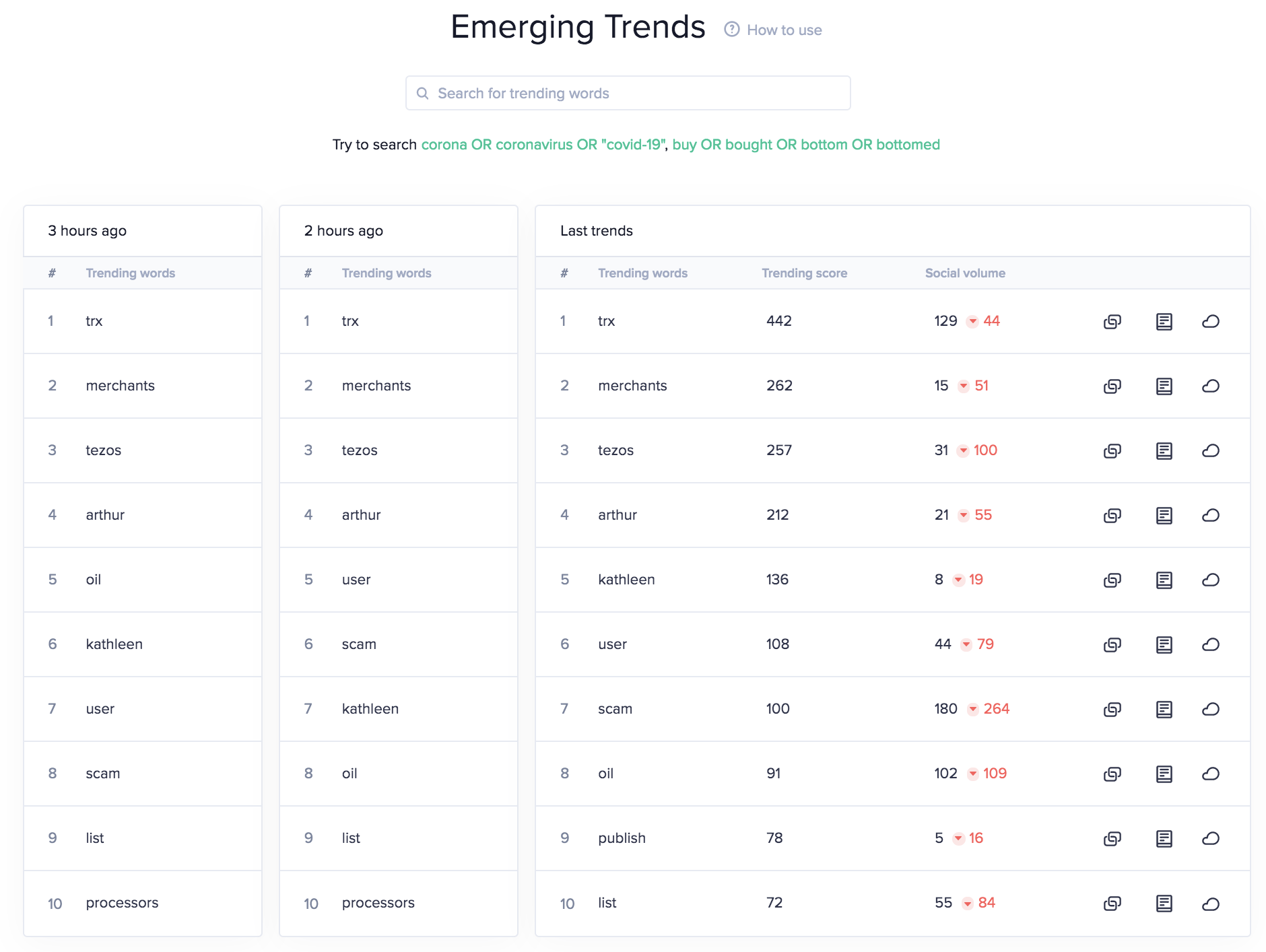Emerging trends

Definition
The Emerging trends (or Trending words) is a list of words that describe the topics which emerged faster than any others over the last 24 hours. By "emerging" we mean getting more social attraction from the crowd, being discussed much more than any other topic.
We detect these words by computing the so called hype score for each single word that is present in the social data after filtering and cleaning the data. Once this number is calculated, the words are ranked according to the corresponding scores in a descending order. The top 10 words in the resulting list are the top emerging trends.
Please note that metrics may undergo changes in historical values due to automated recalculations triggered monthly. We constantly update our labels which helps us to keep labels as fresh as possible but result historical data changes. Any modifications to labels, social sources, or relevant jobs will prompt recalculation for the previous month's data. Within a 12 hour period, metric can be supplemented with new data.
Access
The metric's realtime data is free. The metric's historical data is with restricted access.
Filtering and Cleaning
In order to reduce the level of noise, spam and duplicates while calculating the hype scores, we apply some preprocessing to the text data, namely:
Clean all the texts from stopwords and non-alphabetic characters.
Transform each pair
(user_id, text_documents)to a bag of words representation and remove all the bag of words duplicates.For all the text documents that have more than a certain amount of words in general (usually 5) - remove the exact duplicates (i.e. messages that look exactly the same are considered only once).
These steps help to make the approach robust to spam and multiple replications of the same word or short word combinations.
Hype Score
After the processing is done, for each of the words we calculate the hype score (or trend score). For any timestamp we define the hype score as follows:
where:
is the normalized social volume of the word at the moment (i.e. the usual social volume divided by the total amount of messages in that particular data source),
is the total amount of unique users that have used the word under consideration at least once.
On an intuitive level the hype score tends to be a measuring of how rapidly the social volume of a certain word increased over the last 24 hours in comparison to the past 2 weeks. This is done by comparing the current social volume change to the average social volume of the past 14 days.
Additionally we multiply this factor by this way words with a high social volume and a relatively low amount of unique users, that mentioned it at least once, will have a smaller hype score. For example, if a given word was used many times by exactly one user (i.e. most probably it's heavy spam) this word will have a hype score of 0 thanks to the component. On the other hand, words with 100 and 200 users will have more or less the same chance to get a higher hype score.
It's also worth noticing that we use the normalized social volume instead of the regular one. This makes it easier to compare the resulting hype score across different data sources with different average daily volumes of talks.
Ranking the Words
Once the texts are cleaned and each word has it's hype score, we first rank the words in descending order (the highest hype score goes to the top) and then combine the results across different data sources if necessary: this is done by averaging the hype score for each word across all desired data sources and ranking the words afterwards again. In case a given word is present in source 1 and is not present in source 2 we assume that it's hype score in the second data source is 0.
Measuring Unit
The hype score doesn't really have a qualitative meaning, it can be treated as a relative number: the higher it gets - the faster a given word is "emerging".
Data Type
Frequency
Emerging Trends are available at hourly intervals
Latency
Emerging Trends have social data Latency
Available Assets
The algorithm takes into account all the social data, so the list may or may not contain asset names and tickers. We do track the emerging projects separately for the assets only, but currently it is not available through any of the products.
How to Access
Sanbase
The emerging trends are available in the Labs section.
SanAPI
The emerging trends are available as part of the API, the metric is called
getTrendingWords:
1
2
3
4
5
6
7
8
9
10
11
12
13
14
{
getTrendingWords(
from: "2020-01-01T12:00:00Z"
to: "2020-01-01T13:00:00Z"
size: 10
interval: "1h"
) {
datetime
topWords {
word
score
}
}
}